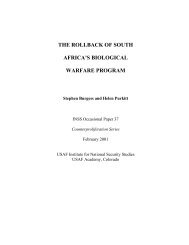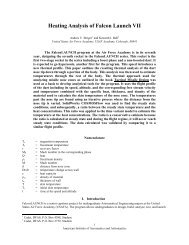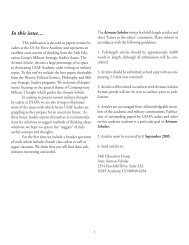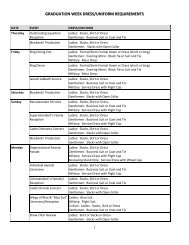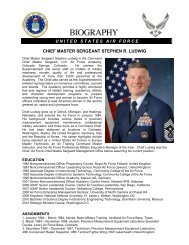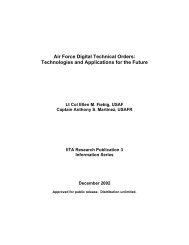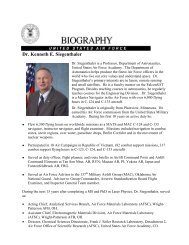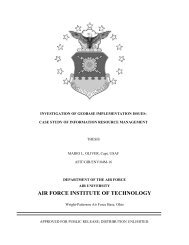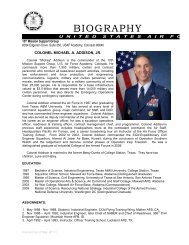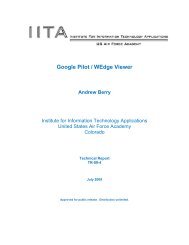Development of High Altitude Sprite Imagery Capability - Bruski
Development of High Altitude Sprite Imagery Capability - Bruski
Development of High Altitude Sprite Imagery Capability - Bruski
Create successful ePaper yourself
Turn your PDF publications into a flip-book with our unique Google optimized e-Paper software.
<strong>Development</strong> <strong>of</strong> <strong>High</strong> <strong>Altitude</strong> <strong>Sprite</strong> <strong>Imagery</strong> <strong>Capability</strong><br />
Shane M. <strong>Bruski</strong> 1<br />
Department <strong>of</strong> Astronautics, USAF Academy, CO, 80840, USA<br />
Caleb W. Whitlock. 2<br />
Department <strong>of</strong> Astronautics, USAF Academy, CO, 80840, USA<br />
Jordan R. Wittman 3<br />
Department <strong>of</strong> Astronautics, USAF Academy, CO, 80840, USA<br />
The United States Air Force Academy Space Club in conjunction with the USAFA Space Physics and<br />
Atmospheric Research Center is developing the capability to study sprites using a specially constructed<br />
payload box carried al<strong>of</strong>t by a meteorological sounding balloon. <strong>Sprite</strong>s are electrostatic discharges that<br />
occur in the upper reaches <strong>of</strong> the mesosphere at altitudes <strong>of</strong> 50-80 kilometers. The study <strong>of</strong> sprites is<br />
important to the understanding and eventual prediction <strong>of</strong> mesospheric weather. The system developed by<br />
the USAFA Space Club uses high-definition, visible spectrum imagery to capture the development and<br />
propagation <strong>of</strong> sprites. In addition, the payload box carries a flight computer with a data logger to record<br />
GPS sensor information. This system has the ability to conform to multiple mission pr<strong>of</strong>iles depending on the<br />
location <strong>of</strong> the sprites. First, the payload can remain relatively stationary from 24 km to 30 km MSL for 4-6<br />
hours in order to maximize viewing time. This is achieved by developing a radio frequency activated release<br />
system to cut away extra sounding balloons providing free lift. Second, the payload can be carried al<strong>of</strong>t very<br />
quickly and released on command to fall back to earth under parachute. The system is optimized for quick<br />
turnaround and rapid deployment; it also <strong>of</strong>fers the unique advantage <strong>of</strong> eliminating atmospheric distortions<br />
because <strong>of</strong> its extreme altitude.<br />
T<br />
I. Introduction<br />
he purpose <strong>of</strong> this study is to develop the capability to study the formation <strong>of</strong> sprites from a high altitude using<br />
sounding balloons. The formation <strong>of</strong> sprites is <strong>of</strong> great interest in order to understand and characterize the space<br />
weather environment. The system to image the sprites will be built using largely <strong>of</strong>f the shelf products in order to<br />
minimize the preparation time and minimize the costs. A series <strong>of</strong> test flights will be conducted that test the<br />
capabilities <strong>of</strong> the flight hardware. First and foremost will be the method <strong>of</strong> tracking and recovering the payloads<br />
after launch using the automatic packet reporting system (APRS) and the global positioning system (GPS). Once<br />
that capability is proven, the next test phase will test the imagery equipment and the cut down system at altitude.<br />
Finally, a long duration flight <strong>of</strong> four to six hours will be conducted at approximately 18-21 km altitude to<br />
demonstrate the ability to remain in a relatively stable position to capture imagery around thunderstorms. To<br />
accomplish these objectives, a flexible integrated balloon and payload system was developed and flown.<br />
II. Tracking and Recovery<br />
To ease cost and complexity issues it is necessary to recover the payload after the mission. A recovery <strong>of</strong> the<br />
payload in downrange from the launch site requires a system that transmits position and altitude data in real time and<br />
can record the data. Accuracy is paramount which led to the development <strong>of</strong> a GPS based tracking system utilizing<br />
the automatic packet reporting system (APRS) network already set up for amateur radio operators. This system<br />
developed incorporates the commercial transceiver called the Argent Data VHF Transceiver with integrated Tracker<br />
2 designed to convert the NMEA sentences output by commercial GPS devices and then to send them down to an<br />
amateur radio via serial packets. Two different GPS units were tested to insure redundancy <strong>of</strong> options. The Garmin®<br />
1<br />
Cadet, Department <strong>of</strong> Astronautics, USAF Academy, CO 80840, and AIAA Member.<br />
2<br />
Cadet, Department <strong>of</strong> Astronautics, USAF Academy, CO 80840, and AIAA Member.<br />
3<br />
Cadet, Department <strong>of</strong> Astronautics, USAF Academy, CO 80840, and AIAA Member.<br />
1<br />
American Institute <strong>of</strong> Aeronautics and Astronautics
18 receiver and the GT-320FW high altitude receiver programmed to work over 25 km were both flight tested and<br />
found to work flawlessly. A terminal node controller (TNC) is then used to translate the packets into the text<br />
formatted readouts <strong>of</strong> altitude, velocity, position, and battery voltage data which is then recorded onto a computer in<br />
real time using serial port monitoring s<strong>of</strong>tware. This data is also transmitted to the network <strong>of</strong> digipeaters set up<br />
throughout the nation which comprise the APRS network. This data is then available live on the website<br />
http://aprs.fi/ and allows people all over the world to see the flight path <strong>of</strong> the balloon in real time. These also have<br />
the option <strong>of</strong> a release and forget type <strong>of</strong> system that does not require a live chase. In flight 5, the APRS system was<br />
critical to finding the payload. More will be discussed in the flight tests and results section.<br />
Since tracking and recovering the payload is required , a redundant system that is completely independent <strong>of</strong> the<br />
APRS system described above is needed. The SPOT® tracker is a commercial device commonly employed by<br />
hikers and other outdoor enthusiasts based on its rugged design for extreme conditions. It can survive being<br />
underwater, can transmit in low areas where the line <strong>of</strong> sight APRS system fails, and is extremely resistant to harsh<br />
weather conditions. This system proved to be ideal for the recovery system particularly when the system descends<br />
below about 762 meters or below the horizon <strong>of</strong> the nearest digipeater tower and the APRS signal is lost.<br />
III. Still and Video <strong>Imagery</strong> Capture<br />
The still and video imagery capturing system is designed to operate in a harsh environment for extended periods<br />
<strong>of</strong> time and still take high quality images in the visible spectrum <strong>of</strong> its surroundings. Since a development from<br />
scratch would prove to be extremely time demanding, the continued use <strong>of</strong> <strong>of</strong>f the shelf commercial items was the<br />
route chosen. A 5 megapixel Nikon P2® digital still camera that was programmed to take photos every minute was<br />
used on flights one and two. This was to prove the feasibility <strong>of</strong> taking a commercial camera not designed to operate<br />
in extreme conditions such as a near vacuum and prove it will operate correctly. In addition, during flight two, a<br />
thunderstorm was seen in one <strong>of</strong> the still photos taken by the Nikon P2® and was later determined to be over 700<br />
miles distant in Texas thus proving the advantage <strong>of</strong> a high altitude camera platform. On flights three and four, a<br />
high definition GoPro Hero Naked® camera was carried aboard to test the feasibility and quality <strong>of</strong> video imagery<br />
with that system. In future flights, it is planned that four HD Hero® cameras will be carried al<strong>of</strong>t to capture as much<br />
<strong>of</strong> the sky as possible. Two cameras will be pointed up each at 45 degrees from the horizontal, one pointed straight<br />
out, and finally one pointed straight down. From flight three, it was determined that from an altitude <strong>of</strong> 30.480 km<br />
with the camera pointed straight down at the ground a 350 km viewing radius was theoretically possible. This results<br />
in a 3801,000 square km viewing area in which to view lightning activity below the balloon.<br />
IV. The Comparison <strong>of</strong> Flight Prediction S<strong>of</strong>tware<br />
Before every flight, a set <strong>of</strong> two commonly used flight prediction s<strong>of</strong>tware programs found online were used to<br />
predict where the balloons were to fly. The models used were Balltrack Online developed by Near Space<br />
Adventures and Balloon Trajectory developed by the University <strong>of</strong> Wyoming. The true value <strong>of</strong> these models lies in<br />
predicting the landing site <strong>of</strong> the balloon. However, these models have different methods <strong>of</strong> calculating the flight<br />
trajectories based on the inputs they require. Therefore, by looking at where the balloons actually landed and where<br />
they were predicted to land gives an estimate <strong>of</strong> which model tends to be more accurate and which parameter causes<br />
them to become inaccurate. The inputs to both models are found below in figures 1 and 2.<br />
2<br />
American Institute <strong>of</strong> Aeronautics and Astronautics
Figure 1. Balltrack Online Input Parameter Example<br />
Figure 2. Balloon Trajectory Input Parameter Example<br />
In summary, it was found that Balltrack Online was the most accurate program <strong>of</strong> the two models so long as<br />
good information was input. A more detailed comparison <strong>of</strong> the actual versus the predicted landing sites lies on the<br />
appendices. In order to be accurate, the Balltrack Online model required accurate ascent and descent rate<br />
information whereas the Balloon Trajectory automatically input those values.<br />
V. Flight Tests and Results<br />
Four flight tests have been conducted thus far. They have all served to test the tracking system and to develop a<br />
comprehensive set <strong>of</strong> launch procedures that will ensure the most successful flights possible. Each <strong>of</strong> the four flights<br />
is summarized below.<br />
A. Flight One<br />
Flight one was a test flight to evaluate the performance <strong>of</strong> a still camera at above 18 km and to test the Garmin®<br />
18 GPS above that altitude as well. A secondary payload <strong>of</strong> a meteorological weather sonde was carried for the<br />
3<br />
American Institute <strong>of</strong> Aeronautics and Astronautics
United States Air Force Academy’s Meteorology Department. The flight reached a maximum altitude <strong>of</strong> 31 km and<br />
landed approximately 88 km north and east <strong>of</strong> the launch location. The unit was recovered successfully with the help<br />
<strong>of</strong> a last second SPOT® tracker unit from a local high school.<br />
B. Flight Two<br />
Flight two was a test <strong>of</strong> the SPOT® tracker at high altitudes, a new payload box, and a new parachute. The<br />
balloon flight was a launch and forgets mission since no live data was being sent down to the ground. The flight<br />
landed approximately 125 miles north and east <strong>of</strong> its launch location. The balloon was recovered at 11 pm in zero<br />
light conditions.<br />
C. Flight Three<br />
Flight three served as a test <strong>of</strong> the HD GoPro Hero Naked® video camera. The camera was pointed straight<br />
down to demonstrate that position for future flights. The flight also demonstrated the necessity <strong>of</strong> having a<br />
redundant tracking system as the APRS feed was lost when the balloon was approximately 762 meters in altitude.<br />
The SPOT® tracker successfully sent its position to the tracking website 170 miles from the launch site. The balloon<br />
was in the air for over four hours which contributed to the extreme distance the balloon landed from the launch site.<br />
A unusual wind pattern at 30 km was identified. Winds usually are calm at 30 km however, on this occasion the<br />
balloon picked up speed reaching a maximum velocity <strong>of</strong> 104.60 km per hour at 31 km in altitude.<br />
D. Flight Four<br />
Flight four served as a test for a new GPS receiver unit and to demonstrate a new flight pr<strong>of</strong>ile used to track<br />
balloons near thunderstorms. This flight was unique in that it used almost exactly the same materials as the last<br />
flight to demonstrate rapid reuse and low turnaround time. A more accurate method <strong>of</strong> measuring lift was developed<br />
to guarantee a short flight. 4.54 kg <strong>of</strong> weights were tied to the bottom <strong>of</strong> the balloon which was then filled until they<br />
could be lifted <strong>of</strong>f the ground. Approximate lift was 11 pounds at launch. At about 35 minutes into the flight and at<br />
an altitude <strong>of</strong> 17 km extreme turbulence was encountered. This combined with a small amount <strong>of</strong> ice buildup on the<br />
cord connecting the parachute to the payload box led to the payload box separating from the balloon and parachute.<br />
The payload box survived a free fall from 17 km to impact at almost 112.63 km per hour with little to no damage.<br />
Again, this flight demonstrated a need for a redundant tracking system as the violent force <strong>of</strong> the impact caused the<br />
SPOT tracker to turn <strong>of</strong>f. The box was located using previous data points to calculate descent rate and then<br />
combined with the winds that day to draw a probability circle to where it landed. The system was still transmitting<br />
its position 24 hours later which was picked up by HAM radio and when entered into a handheld GPS led straight to<br />
its recovery site.<br />
VI. Future Test Flights<br />
Two final test flights remain before the system is considered operational. The first test will demonstrate the<br />
ability <strong>of</strong> the system to successfully cut the balloon away from the parachute using a HAM radio to send a signal to<br />
a receiver onboard the balloon. This signal will be in the form <strong>of</strong> a coded sequence <strong>of</strong> numbers that will be read by a<br />
DTMF (dual tone multi-frequency) board and will activate a relay switch. This switch will allow current to flow<br />
through a nichrome wire wrapped around the nylon cord connecting the balloon to the parachute. With the current<br />
flow, the wire will heat up and melt through the string in a matter <strong>of</strong> seconds. In all previous flights, the balloons<br />
have failed to shred as they are designed to do at altitude. They remain mostly intact as 2-3 kg <strong>of</strong> dead weight above<br />
the parachute causing it to only partially inflate enter into a fast than expected fall. The cut down system will allow a<br />
precise maximum altitude and a more predictable landing site. Finally the second test flight that remains will serve<br />
as a test <strong>of</strong> the high altitude long duration flight at a relatively stable position. Through previous flights and the<br />
advice <strong>of</strong> the USAF Academy Meteorology Department, a region at approximately 18-21 km has been found to<br />
contain winds that are below 16.09 km per hour. This altitude is ideal for long duration flights as it is high enough to<br />
be above most <strong>of</strong> the atmospheric distortion and out <strong>of</strong> the winds. Should this region not prove to be calm, the flight<br />
will continue to rise until a calm region is found. At launch, the flight will consist <strong>of</strong> two balloons connected<br />
separately to the payload box. The large main balloon will be filled to the point where its lift exactly matches the<br />
weight <strong>of</strong> the payload and the system will be neutrally buoyant. The second smaller balloon will simply to provide<br />
the lift needed to get the system up to the desired altitude. A separate cut down device will be connected to each <strong>of</strong><br />
the balloons and at that desired altitude, the balloon providing the free lift will be cut away and the system will<br />
4<br />
American Institute <strong>of</strong> Aeronautics and Astronautics
ecome neutrally buoyant. After 4-6 hours, the main balloon will be cut away as helium will begin to diffuse<br />
through the walls <strong>of</strong> the balloon and the system begins to sink. This flight will be the final flight before the system<br />
becomes operational and long duration flights studying sprites are possible. Finally, a new spring scale was acquired<br />
to allow precise measurements <strong>of</strong> lift which will enable a more accurate relation between ascent rate and the amount<br />
<strong>of</strong> helium in the balloon.<br />
Appendix A<br />
Balloon Ground Tracks and GPS Coordinates<br />
Figure A1.Balloon Trajectory Forecast for Flight One<br />
Figure A2. Balltrack Online Forecast Flight One*<br />
5<br />
American Institute <strong>of</strong> Aeronautics and Astronautics
Figure A3. Balloon One’s Actual Landing Site<br />
Figure A4. Flight Two Balloon Trajectory Prediction<br />
Figure A5. Flight Two Balltrack Online Prediction*<br />
6<br />
American Institute <strong>of</strong> Aeronautics and Astronautics
Figure A6. Flight Two SPOT Tracker Coordinates Actual<br />
Figure A7. Flight Three Balloon Trajectory Prediction<br />
Figure A8. Flight Three Balltrack Online Prediction*<br />
7<br />
American Institute <strong>of</strong> Aeronautics and Astronautics
Figure A9. Flight Three SPOT Tracker Coordinates Actual<br />
Figure A10. Flight Three APRS Data Google Maps Actual<br />
In summary, the Ball Track Online outperformed the Balloon Trajectory for landing accuracy on two <strong>of</strong> the three<br />
flight tests. The Ball Track Online s<strong>of</strong>tware was found to be more flexible and more able to take into account the<br />
changes in the balloon parameters. Those parameters included the ascent rate and the descent rate neither <strong>of</strong> which<br />
could be input into the Balloon Trajectory. These two parameters are absolutely critical for the duration the balloon<br />
is in the air as they determine how long the balloon will remain in the winds al<strong>of</strong>t. Consequently, these parameters<br />
determine how far the winds will push the balloon. Although the Ball Track Online was found to be more accurate,<br />
the practice <strong>of</strong> comparing the two models will still be continued. If they agree on direction, then it can be concluded<br />
the weather data going into them will yield a valid flight path <strong>of</strong> the balloon and their results can be trusted.<br />
*Note that the blue line is the balloon’s ascent and the red is the descent<br />
8<br />
American Institute <strong>of</strong> Aeronautics and Astronautics
Appendix B<br />
Flight <strong>Imagery</strong><br />
Figure B1. Flight Configuration<br />
Figure B2. Thunderstorm Located in Texas<br />
700 miles From Launch Site<br />
9<br />
American Institute <strong>of</strong> Aeronautics and Astronautics
Figure B3. HD Video Camera View Looking<br />
Straight Down from 100,000 Feet<br />
Acknowledgments<br />
A great deal <strong>of</strong> faith has been placed in us by the Space Club’s advisor; Dr. Ken Siegenthaler who was has<br />
continually encouraged us to expand our horizons. Without him, this project would never have lifted <strong>of</strong>f the ground.<br />
A special thanks also goes to Dr. Ge<strong>of</strong>f Mcharg who supports these endeavors as we work towards imaging high<br />
altitude sprites. We also want to thank Mr. John Clark for his advice and help with the electronics.<br />
References<br />
Website<br />
1 Glahn, Rick von, “Balloon Related Programs”, URL: http://www.eoss.org/bals<strong>of</strong>t.htm [cited 06 March 2011].<br />
10<br />
American Institute <strong>of</strong> Aeronautics and Astronautics



